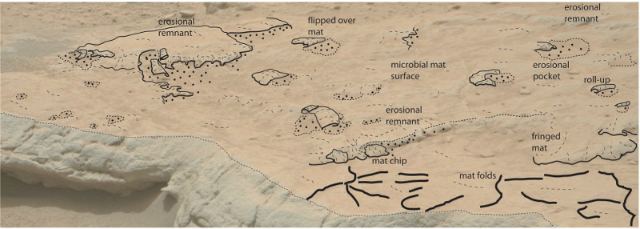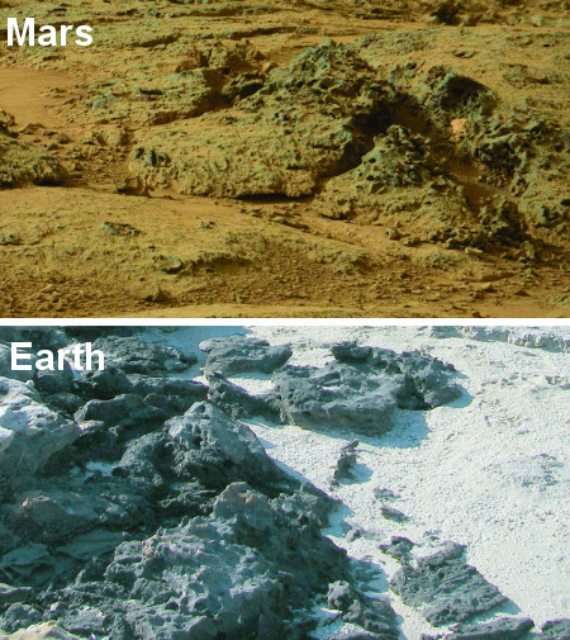Having carefully considered the latest images sent by the rover NASA Curiosity, scientists have revealed intriguing similarities between the ancient sedimentary rocks on Mars rocks exposed organisms on Earth. The findings suggest that life could have once existed on the Red Planet, but do not provide unequivocal evidence.
The pictures were taken during the movement “Kyuriositi” on Lake Gillespie in Yellowknife Bay. Currently, it is a dry region, but billions of years ago he experienced seasonal flooding. Mars and Earth’s early history is about the same, but at the time the Red Planet was much warmer and wetter world.
On Earth colonies of microbes lived in shallow water bodies (lakes and coastal areas). Scientists have found that they are responsible for the formation of the characteristic features, frozen in stone over time. These structures, known as microbially induced sedimentary structures (microbially induced sedimentary structure), located in the ancient rocks all over the world.

Geobiology Nora Noffke (Nora Noffke) studied similar structures nearly two decades. Last year, it reported the discovery of sedimentary structures age of 3.48 billion years in the territory of Dresser formation in Western Australia. This is probably the oldest evidence of life on our planet.
Now Noffke found striking morphological similarities Martian sedimentary structures in the sediments of Lake Gillespie (who, apparently, about 3.7 billion years old) with microbial structures left in rock on Earth. The researcher compared the pictures from Mars with images of many regions of the Earth, including the sedimentary rocks of the island Mellum (Germany), Portsmouth Island (USA) and Karbla Point in Western Australia.
The characteristics of microbial structures include erosional marks pockets, cupolas, creases, holes and cracks that our planet can spread out over a distance of a few centimeters to several kilometers.

The hypothesis Noffke is not direct evidence that these structures were formed biologically – it is only an intriguing possible sign that the ancient Mars was microbial life. Getting confirm or refute hypotheses are possible after samples of Martian rocks will be delivered to the Earth and will undergo microscopic analysis.
However, in the near future, this mission was not planned, but a tool of the rover, which theoretically could try to distinguish the signature of microorganisms was dirty. So while these findings remain only at the stage of speculation.
But experts still believe that these guesses, along with the recent discovery of methane and organic matter on Mars, researchers added confidence, believes that a neighboring planet once existed life.

Scientists have repeatedly pointed to the similarity of the Martian and terrestrial rocks, but to date the findings Noffke – the most compelling.
Microbial structure occurring in the world, look Therefore differently depending on where they are located. For example, the patterns found in the photographs of the lake sediments Gillespie, like microbial structures found in similar conditions in the world.
Also Noffke noticed that the structure changed over time. In his scientific article in the publication of Astrobiology, it also describes the alternative processes that could generate such deposits (eg, exposure to salt water or wind).
No comments:
Post a Comment